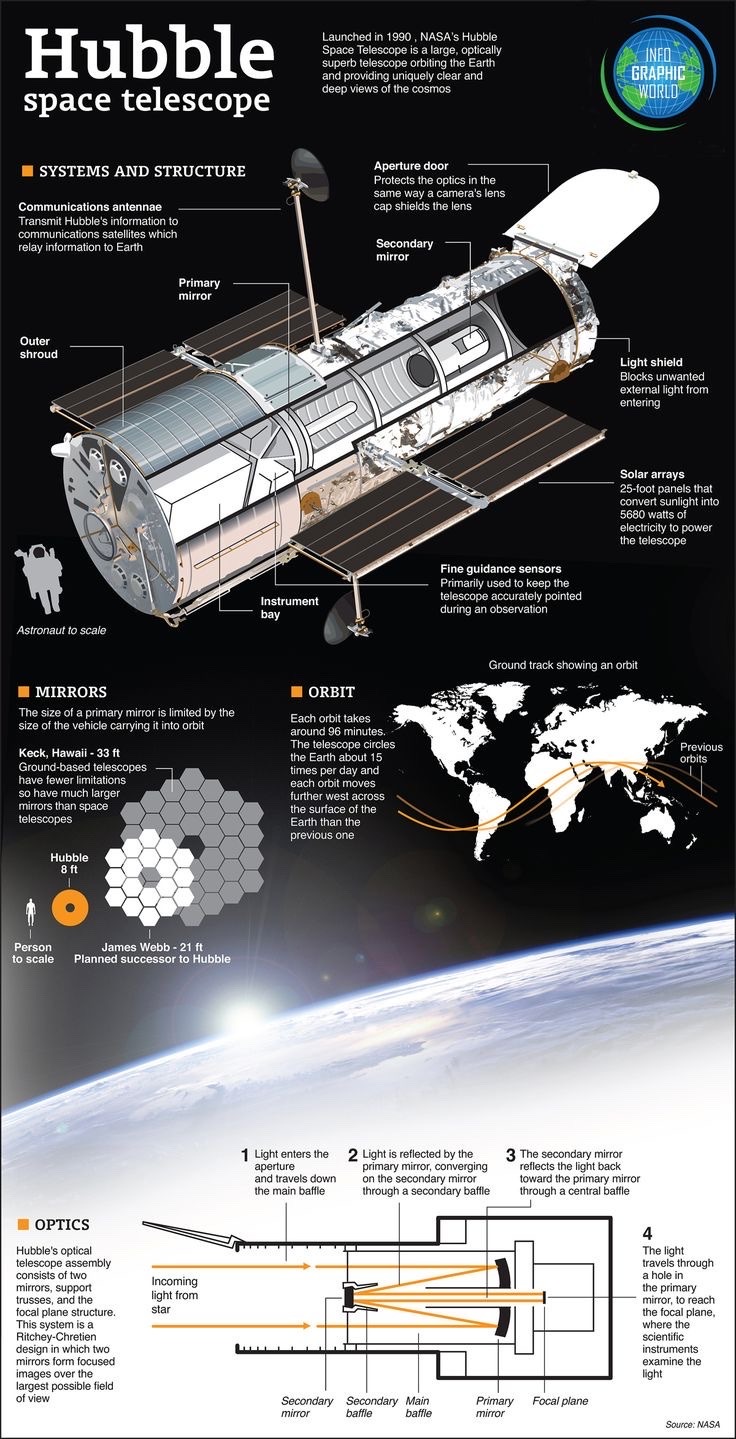Text

this year while we all celebrate pride month and celebrate ourselves as well as those who came before us and paved the way for us to do so, we must also think of those in gaza, queer or not, who live every day under a brutal occupation and don’t have that same privilege. happy pride, and may we see a free palestine in this lifetime.
50K notes
·
View notes
Text

my heart absolutely breaks for gaza. imagine screaming for help. for someone to save you and the world ignores you for the most part. shame on anyone and everyone who supports this. where is your empathy.
46K notes
·
View notes
Note
youre nb but you call yourself a bitch (bitch is a FEMALE dog btw) why???
i am on the FLOOR
321K notes
·
View notes
Text
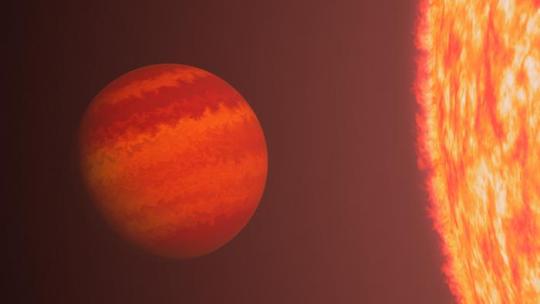
‘Weird’ new planet retained atmosphere despite nearby star’s relentless radiation
A rare exoplanet that should have been stripped down to bare rock by its nearby host star’s intense radiation somehow grew a puffy atmosphere instead—the latest in a string of discoveries forcing scientists to rethink theories about how planets age and die in extreme environments.
Nicknamed “Phoenix” for its ability to survive its red giant star’s radiant energy, the newly discovered planet illustrates the vast diversity of solar systems and the complexity of planetary evolution—especially at the end of stars’ lives.
The findings are published in The Astronomical Journal.
“This planet isn’t evolving the way we thought it would, it appears to have a much bigger, less dense atmosphere than we expected for these systems,” said Sam Grunblatt, a Johns Hopkins University astrophysicist who led the research. “How it held on to that atmosphere despite being so close to such a large host star is the big question.”
The new planet belongs to a category of rare worlds called “hot Neptunes” because they share many similarities with the solar system’s outermost, frozen giant despite being far closer to their host stars and far hotter. Officially named TIC365102760 b, the latest puffy planet is surprisingly smaller, older, and hotter than scientists thought possible. It is 6.2 times bigger than Earth, completes an orbit around its parent star every 4.2 days, and is about 6 times closer to its star than Mercury is to the Sun.
Because of Phoenix’s age and scorching temperatures, coupled with its unexpectedly low density, the process of stripping its atmosphere must have occurred at a slower pace than scientists thought possible, the scientists concluded. They also estimated that the planet is 60 times less dense than the densest “hot Neptune” discovered to date, and that it won’t survive more than 100 million years before it begins dying by spiraling into its giant star.
“It’s the smallest planet we’ve ever found around one of these red giants, and probably the lowest mass planet orbiting a [red] giant star we’ve ever seen,” Grunblatt said. “That’s why it looks really weird. We don’t know why it still has an atmosphere when other ‘hot Neptunes’ that are much smaller and much denser seem to be losing their atmospheres in much less extreme environments.”
Grunblatt and his team were able to gain such insights by devising a new method for fine-tuning data from NASA’s Transiting Exoplanet Survey Satellite. The satellite’s telescope can spot low-density planets as they dim the brightness of their host stars when passing in front of them. But Grunblatt’s team filtered out unwanted light in the images and then combined them with additional measurements from the W.M. Keck Observatory on Hawaii’s Maunakea volcano, a facility that tracks the tiny wobbles of stars caused by their orbiting planets.
The findings could help scientists better understand how atmospheres like Earth’s might evolve, Grunblatt said. Scientists predict that in a few billion years the sun will expand into a red giant star that will swell up and engulf Earth and the other inner planets.
“We don’t understand the late-stage evolution of planetary systems very well,” Grunblatt said. “This is telling us that maybe Earth’s atmosphere won’t evolve exactly how we thought it would.”
Puffy planets are often composed of gases, ice, or other lighter materials that make them overall less dense than any planet in the solar system. They are so rare that scientists believe only about 1% of stars have them. Exoplanets like Phoenix are not as commonly discovered because their smaller sizes make them harder to spot than bigger, denser ones, Grunblatt said. That’s why his team is searching for more of these smaller worlds. They already have found a dozen potential candidates with their new technique.
“We still have a long way to go in understanding how planetary atmospheres evolve over time,” Grunblatt said.
Other authors are: Nicholas Saunders, Daniel Huber, and Ashley Chontos of the University of Hawaii at Mãnoa; Daniel Thorngren and Kevin Schlaufman of Johns Hopkins University; Shreyas Vissapragada and Stephanie Yoshida of Harvard University; Steven Giacalone, Emma Turtelboom, and Howard Isaacson of the University of California, Berkeley; Mason Macdougall of the University of California, Los Angeles; Corey Beard of the University of California, Irvine; Joseph M. Akana Murphy of the University of California, Santa Cruz; Malena Rice of Yale University; Ruth Angus of the American Museum of Natural History, Flatiron Institute, and Columbia University; and Andrew W. Howard of the California Institute of Technology.
This work was supported by a NASA Keck PI Data Award, administered by the NASA Exoplanet Science Institute. Data from the Keck Observatory came via telescope time allocated to NASA.
The scientists wish to recognize and acknowledge the significant cultural role and reverence that the summit of Maunakea has within the Indigenous Hawaiian community.
IMAGE....Artist’s concept of TIC365102760 b, nicknamed Phoenix for its ability to survive a red giant star’s intense radiation from up close. Credit Roberto Molar Candanosa/Johns Hopkins University
5 notes
·
View notes
Text
USEFUL WEBSITES FOR WRITERS
Writing With Color: Helps with writing about culture, ethnicity, and religion. Overall, it gives advice on how to write about diversity.
Name Generator: As the name says, it helps you build names for your characters. Very useful if you cannot think of names for your characters!
KathySteinemann: The 'archive.pdf' section helps you with synonyms in case you struggle to find the right word for your sentences (also to avoid using redundant words).
Spwickstrom: Similar to the previous one, this one provides grammar tips. Extremely helpful when finding phrases, verbs, conjunctions, adjectives, and so on.
Servicescape: The perfect website if you're experiencing writer's block. It provides writing prompts. It helps you spark creativity when it comes to writing.
reblog to help other writers !!
8K notes
·
View notes
Text

Got to do some research on this ("Cosmic Cliffs" in the Carina Nebula). I can’t stop staring at it…
59 notes
·
View notes
Text

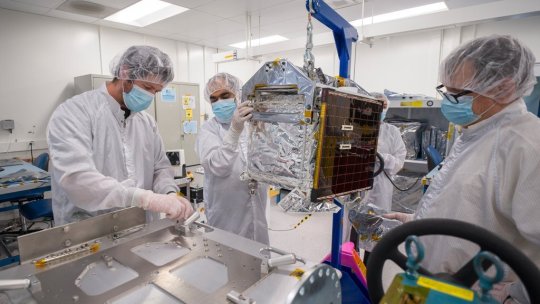

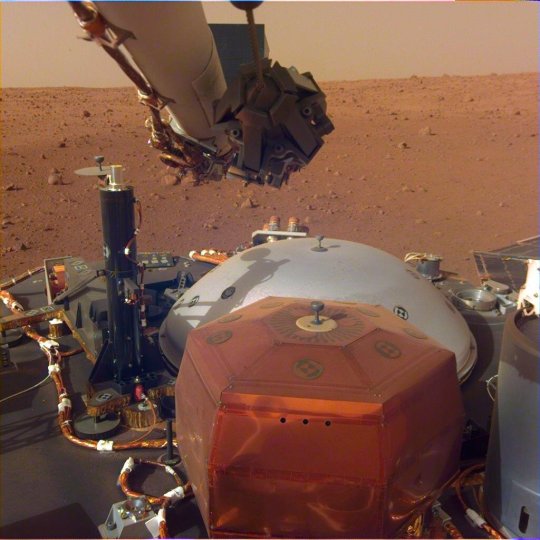
NASA to measure moonquakes with help from InSight Mars mission
The technology behind the two seismometers that make up NASA's Farside Seismic Suite was used to detect more than a thousand Red Planet quakes.
The most sensitive instrument ever built to measure quakes and meteor strikes on other worlds is getting closer to its journey to the mysterious far side of the moon. It's one of two seismometers adapted for the lunar surface from instruments originally designed for NASA's InSight Mars lander, which recorded more than 1,300 marsquakes before the mission's conclusion in 2022.
Part of a payload called Farside Seismic Suite (FSS) that was recently assembled at NASA's Jet Propulsion Laboratory in Southern California, the two seismometers are expected to arrive in 2026 at Schrödinger basin, a wide impact crater about 300 miles (500 kilometers) from the moon's South Pole. The self-sufficient, solar-powered suite has its own computer and communications equipment, plus the ability to protect itself from the extreme heat of lunar daytime and the frigid conditions of night.
Lunar seismic firsts
After being delivered to the surface by a lunar lander under NASA's CLPS (Commercial Lunar Payload Services) initiative, the suite will return the agency's first seismic data from the moon since the last Apollo program seismometers were in operation nearly 50 years ago. Not only that, but it will also provide the first-ever seismic measurements from the moon's far side.
Up to 30 times more sensitive than its Apollo predecessors, the suite will record the moon's seismic "background" vibration, which is driven by micrometeorites the size of small pebbles that pelt the surface. This will help NASA better understand the current impact environment as the agency prepares to send Artemis astronauts to explore the lunar surface.
Planetary scientists are eager to see what FSS tells them about the moon's internal activity and structure. What they learn will offer insights into how the moon—as well as rocky planets like Mars and Earth—formed and evolved.
It will also answer a lingering question about moonquakes: Why did the Apollo instruments on the lunar near side detect little far-side seismic activity? One possible explanation is that something in the moon's deep structure essentially absorbs far-side quakes, making them harder for Apollo's seismometers to have sensed. Another is that there are fewer quakes on the far side, which on the surface looks very different from the side that faces Earth.
"FSS will offer answers to questions we've been asking about the moon for decades," said Mark Panning, the FSS principal investigator at JPL and project scientist for InSight. "We cannot wait to start getting this data back."
Mars-to-moon science
Farside Seismic Suite's two complementary instruments were adapted from InSight designs to perform in lunar gravity—less than half that of Mars, which, in turn, is about a third of Earth's. They're packaged together with a battery, the computer, and electronics inside a cube structure that's surrounded by insulation and an outer protective cube. Perched atop the lander, the suite will gather data continuously for at least 4½ months, operating through the long, cold lunar nights.
The Very Broadband seismometer, or VBB, is the most sensitive seismometer ever built for use in space exploration: It can detect ground motions smaller than the size of a single hydrogen atom. A fat cylinder about 5 inches (14 centimeters) in diameter, it measures up-and-down movement using a pendulum held in place by a spring. It was originally constructed as an emergency replacement instrument (a "flight spare") for InSight by the French space agency, CNES (Centre National d'Études Spatiales).
Philippe Lognonné of Institut de Physique du Globe de Paris, the principal investigator for InSight's seismometer, is an FSS co-investigator and VBB instrument lead. "We learned so much about Mars from this instrument, and now we are thrilled with the opportunity to turn that experience toward the mysteries of the moon," he said.
The suite's smaller seismometer, called the Short Period sensor, or SP, was built by Kinemetrics in Pasadena, California, in collaboration with the University of Oxford and Imperial College, London. The puck-shaped device measures motion in three directions using sensors etched into a trio of square silicon chips each about 1 inch (25 millimeters) wide.
Assembled and tested
The FSS payload came together at JPL over the last year. In recent weeks, it survived rigorous environmental testing in vacuum and extreme temperatures that simulate space, along with severe shaking that mimics the rocket's motion during launch.
"The JPL team has been excited from the beginning that we're going to the moon with our French colleagues," said JPL's Ed Miller, FSS project manager and, like Panning and Lognonné, a veteran of the InSight mission. "We went to Mars together, and now we'll be able to look up at the moon and know we built something up there. It'll make us so proud."
TOP IMAGE....Seen here during assembly in November 2023, Farside Seismic Suite’s inner cube houses the NASA payload’s large battery (at rear) and its two seismometers. The gold, puck-shaped device holds the Short Period sensor, while the silver enclosure contains the Very Broadband seismometer. Credit: NASA/JPL-Caltech
CENTRE IMAGE....JPL engineers and technicians prepare NASA’s Farside Seismic Suite for testing in simulated lunar gravity, which is about one-sixth of Earth’s. The payload will gather the agency’s first seismic data from the Moon in nearly 50 years and take the first-ever seismic measurements from the far side. Credit: NASA/JPL-Caltech
LOWER IMAGE....NASA’s Farside Seismic Suite undergoes work in a JPL clean room in March. The instrument’s two sensitive seismometers are packaged in a cube-within-a-cube structure with a battery, a computer, and electronics. The shiny blanket is an outer insulating layer; the single solar panel provides power. Credit: NASA/Caltech
BOTTOM IMAGE....The Seismic Experiment for Interior Structure instrument (SEIS) aboard NASA’s Mars InSight is within the copper-colored hexagonal enclosure in this photo taken by a camera on the lander’s robotic arm on Dec. 4, 2018. The SEIS technology is being used on Farside Seismic Suite, bound for the Moon. Credit: NASA/JPL-Caltech
5 notes
·
View notes
Text
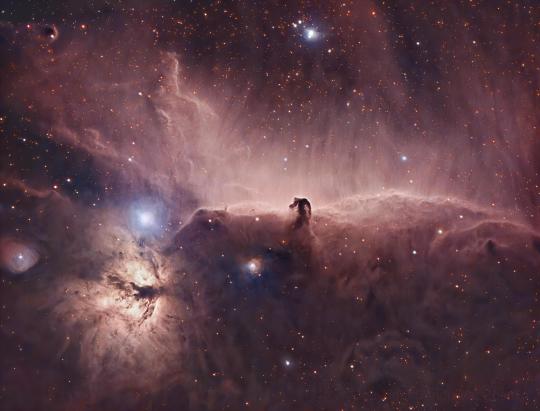
The Horsehead Nebula (Barnard 33, center) and the Flame Nebula (NGC 2024, bottom left) // Sandu Val Cosmin
145 notes
·
View notes
Text

Here’s a detailed look at the violent active region on the sun that has continued to flare for several weeks now. This was captured from my backyard this afternoon. This Sunspot is now Earth facing- so any CMEs produced are more likely to impact Earth’s magnetosphere.
77 notes
·
View notes
Text
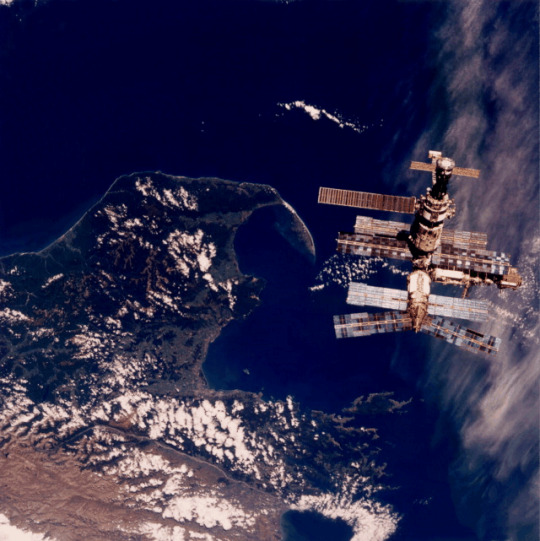
Mir Dreams - June 3rd, 1996.
"This dream-like image of Mir was recorded by astronauts as the Space Shuttle Atlantis approached the Russian Space Station prior to docking during the STS-76 mission. Sporting spindly appendages and solar panels, Mir resembled a whimsical flying insect as it orbited above New Zealand's South Island, near the Cook Strait. Atlantis shuttled astronaut Shannon W. Lucid to Mir for a 140 day visit, increasing the Mir's occupancy from two to three. It would return to pick Lucid up and drop off astronaut John Blaha during the STS-79 mission, which was scheduled for launch on July 31st, 1996."
29 notes
·
View notes






